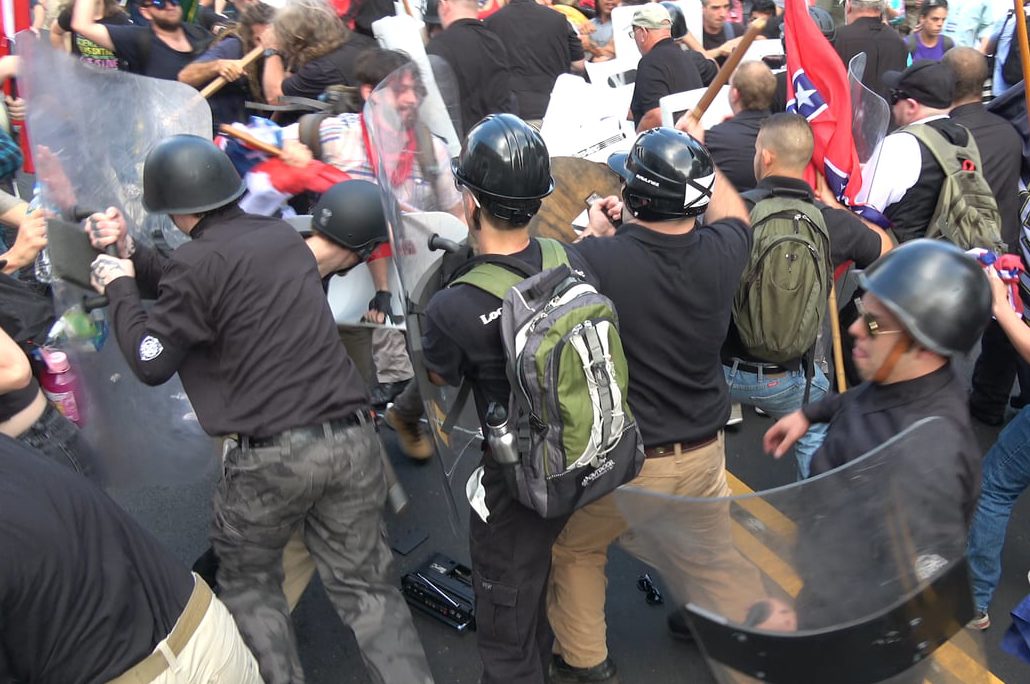Tuesday, August 15th 2017 (WASHINGTON) – The images out of Charlottesville over the weekend showed a shockingly large number of individuals sporting fascist insignia, using the Nazi salute, carrying torches reminiscent of Ku Klux Klan rallies and marching with swastika and Confederate flags side by side. On the other side, a contingent militant anti-fascists (Antifa) hurled bricks and made use of make-shift flame throwers.
President Donald Trump pointed to the two sides of the violent clashes over the weekend telling reporters that both sides were to blame. “You had a group on one side that was bad and you had a group on the other side that was also very violent, and nobody wants to say that,” the president said.
PERMANENT LINK: foxbaltimore.com/news/
Despite the clear evidence of violence perpetrated by both sides, experts in U.S. domestic terrorism and government agencies have compiled data showing a high proportion of violent right-wing extremism that outpaces both Islamist extremism or violence on the far-left.
In recent years, former domestic terrorism analyst at the Department of Homeland Security Daryl Johnson has noted a growing presence of white nationalist radicals that has largely gone unacknowledged by the government, and the rallies over the weekend show a new generation is on the rise.
“Before 2007 you would get between 10 to 15 members of the Klan or neo-Nazi groups showing up [at rallies],” Johnson explained. “The fact that they’re drawing hundreds of people to these rallies is very concerning, because for every one of these individuals who shows up in public and engages in these hateful rants, there are ten others who are sitting at home not participating.”
EXTREMISM BY THE NUMBERS:
The landscape for domestic U.S. extremism is dominated by far-right groups, including KKK, neo-Nazi and other racial supremacists, as well as religious extremists and military. On the left, the violent extremist groups have historically been centered around anarchist, communist, environmentalist and black nationalist groups, accounting for fewer violent attacks.
According to data gathered by the University of Maryland consortium for the Study of Terrorism and Responses to Terrorism (START), individuals associated with far-right groups account for highest number of violent, radicalized individuals in the country, outpacing Islamist and far-left extremists combined.
While Islamists killed nearly seven times as many people than far-right extremists between 1990 and 2017 (including nearly 3,000 on Septmeber 11, 2001) the total number of attacks from the right were greater.
Like any branch of extremist ideology, the number of actively violent radicalized individuals is far less than the number of supporters for a cause that openly advocates violence or genocide.
According to Johnson, who now leads a domestic terrorism consultancy firm, DT Analytics, the number of people supporting the white supremacy movement in the United States is likely in the hundreds of thousands.
“Of those hundreds of thousands there are probably hundreds who are radicalizing … and mobilizing towards violent action and criminal activity,” Johnson said. “Can you imagine having 100,000 ISIS supporters here in the United States and what type of threat that would pose?”
While its messaging has not always openly or explicitly promoted violence, the far-right has a long-established presence on the internet and in social media. White supremacists groups even pioneered a tactic adopted by al-Qaeda, re-purposing first-person shooter video games to target particular races and appeal to young recruits.
SOCIAL MEDIA MESSAGING AND RECRUITING:
Last year, George Washington University’s Center on Extremism compared the number of ISIS followers to the number of followers of the American white nationalist movement and found that white nationalists, neo-Nazis in particular, outperformed ISIS on Twitter in nearly every social metric.
Between 2012 and 2016, accounts created by major white nationalist increased their followers by 600 percent across the board. The accounts regularly focused on “white genocide,” the idea that diversity is a threat to the “white race,” and pro-Nazi propaganda and iconography.
“The clear advantage enjoyed by white nationalists was attributable in part to the effects of aggressive suspensions of accounts associated with ISIS networks,” author of the report J.M. Berger wrote.
Since 2016, Twitter has suspended more than a quarter-million suspected terrorist accounts in response to ISIS’ propaganda efforts. The social media company could not comment on the the number of white nationalist or neo-Nazi accounts suspended, but a spokesperson noted that they “will take action” on any accounts that violate their terms of use prohibiting “hateful conduct.”
Twitter reportedly took action against the Daily Stormer years before it was banned by Google and GoDaddy. The neo-Nazi message board boasted itself as “the world’s most genocidal Republican website” and promoted Nazi ideology, like eugenics and racial purity.
Facebook has also been part of the effort to shut down terrorist propaganda channels on its network and has blocked a number of accounts used by white supremacists or neo-Nazis to organize on their platform.
Some of the groups Facebook has blocked for hate speech and hate organizing include Right Wing Death Squad, Physical Removal, Genuine Donald Trump, White Nationalists United and Vanguard America.
POLITICS PRIMED THE ENVIRONMENT:
Social media may make organizing rallies and connecting with like-minded individuals easier, but the political environment has made extremism appear to be a more legitimate outlet.
According to Braniff, the highly politicized political environment and lack of compromise from opposing political viewpoints has contributed to the cause of domestic extremists.
“A polarized political climate will create that kind of environment where violent outcomes are more likely,” he advised, blaming both the media and political establishment. “The more polarized a society is, the easier it is to mobilize people to a more extreme point because they don’t see a middle ground.”
The increased polarization within American politics has also coincided with the growth and resurgence of radical groups on the left and right.






